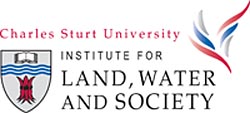 The final report of ‘The Garnaut Climate Change Review’, released on Tuesday 30 September, offers a constructive way forward, according to a senior Charles Sturt University (CSU) academic.
The final report of ‘The Garnaut Climate Change Review’, released on Tuesday 30 September, offers a constructive way forward, according to a senior Charles Sturt University (CSU) academic.Professor Kevin Parton, Strategic Research Professor at Charles Sturt University’s (CSU) Institute of Land, Water and Society, says that Professor Garnaut’s assessment suggests that there is a pathway for Australia to become a low-emissions economy and at the same time continue with strong growth in material living standards, with the agriculture sector a major beneficiary.
“The general consensus from economic analyses already completed is that most of us will probably not notice the difference in our standard of life under a carbon trading scheme, as long as it starts soon and as long as there are appropriate taxation offsets that compensate the less well-off people and support economic growth,” Professor Parton said.
“According to CSU research, without an emissions trading scheme we would expect average incomes to rise from $47 600 today to $64 200 in 2020. With the scheme it would be $63 558 in 2020.”
The Garnaut Report compares the costs and benefits of mitigation to stabilise the amount of carbon dioxide in the atmosphere at 550 parts per million (ppm) and 450ppm, and shows the time profile of the impact on gross domestic product (GDP).
“The impacts after the initial shock are not as small as previously estimated, but are still small, at about 0.1 per cent of GDP per year,” Professor Parton said. “So Garnaut still sees the impacts as small in the long run and household incomes will continue to rise.
“The big issue is the estimated differences in the environmental consequences of different levels of mitigation. Without any scheme, Garnaut suggests that the probability of a 6 degree Celsius temperature increase by 2100 is about 50 per cent, and this would lead to catastrophic consequences.
“We can only contemplate mitigation at either 550ppm or 450ppm (or less), and importantly, there are significant environmental differences between them. At 550 we could probably expect the destruction of the Great Barrier Reef. At 450 there would be mass bleaching of coral, but the reef’s disappearance would be much less likely. While Garnaut doesn’t give his opinion directly in favour of one level of mitigation rather than another, he clearly prefers the 450ppm level.”
Professor Parton says the report has considered whether this proposal will assist in the development of a future international agreement for reducing greenhouse gases. However, others have suggested alternatives that seem to offer more promise of easily moving to an internationally acceptable and globally efficient scheme.
“While a globally-traded free market in carbon would seem to offer the most efficient arrangement, there are serious institutional impediments to establishing it, and there should be no need to offer free permits to big polluters in Australia, except as a temporary transitional arrangement.
“The Garnaut policy proposal is to be implemented over a number of years, by which time the current US and global financial crisis will have resolved itself,” Professor Parton said.






Social
Explore the world of social